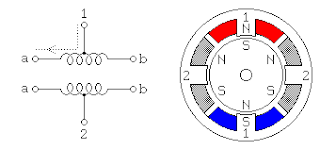Stepper motor :tutorial

what is it :
A stepper motor is a permanent magnet or variable reluctance dc motor that has the following performance characteristics:
rotation in both directions,
precision angular incremental changes,
repetition of accurate motion or velocity profiles,
a holding torque at zero speed, and
capability for digital control.
A stepper motor can move in accurate angular increments knows as steps in response to the application of digital pulses to an electric drive circuit from a digital controller. The number and rate of the pulses control the position and speed of the motor shaft. Generally, stepper motors are manufactured with steps per revolution of 12, 24, 72, 144, 180, and 200, resulting in shaft increments of 30, 15, 5, 2.5, 2, and 1.8 degrees per step.
Stepper motors are either bipolar, requiring two power sources or a switchable polarity power source, or unipolar, requiring only one power source. They are powered by dc current sources and require digital circuitry to produce the coil energizing sequences for rotation of the motor. Feedback is not always required for control, but the use of an encoder or other position sensor can ensure accuracy when it is essential
where to get it :
old floppy drive from junk yards :)
more.....>
http://hades.mech.northwestern.edu/wiki/index.php/Stepper_Motor_Theory
A stepper motor is a permanent magnet or variable reluctance dc motor that has the following performance characteristics:
rotation in both directions,
precision angular incremental changes,
repetition of accurate motion or velocity profiles,
a holding torque at zero speed, and
capability for digital control.
A stepper motor can move in accurate angular increments knows as steps in response to the application of digital pulses to an electric drive circuit from a digital controller. The number and rate of the pulses control the position and speed of the motor shaft. Generally, stepper motors are manufactured with steps per revolution of 12, 24, 72, 144, 180, and 200, resulting in shaft increments of 30, 15, 5, 2.5, 2, and 1.8 degrees per step.
Stepper motors are either bipolar, requiring two power sources or a switchable polarity power source, or unipolar, requiring only one power source. They are powered by dc current sources and require digital circuitry to produce the coil energizing sequences for rotation of the motor. Feedback is not always required for control, but the use of an encoder or other position sensor can ensure accuracy when it is essential
where to get it :
old floppy drive from junk yards :)
more.....>
http://hades.mech.northwestern.edu/wiki/index.php/Stepper_Motor_Theory
Comments
Post a Comment